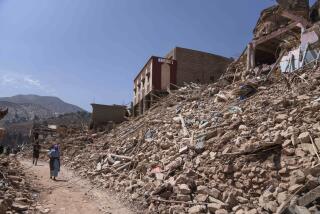Securing Your Chimney in Case of Quake : Home improvement: Anchoring brick chimneys can help keep them from collapsing during an earthquake.
Perhaps the most powerful lesson of the Northridge earthquake is that living where we do--in one of the most seismically active areas of the world--we must take as many realistic steps as possible to reduce the hazards we face in our homes.
We have heard a lot about the importance of bolting houses to their foundations, anchoring furniture and water heaters, installing automatic gas shut-off valves to protect against fire and other safety measures.
One very important precaution that has not been publicized, however, is anchoring or bracing brick chimneys to the roof-rafter system to help keep them from collapsing.
Chimney failures were extraordinarily widespread on Jan. 17. A number of people were injured by flying debris, and it was only the luck of the timing of the temblor that many deaths did not result from tons of bricks falling into living rooms all over the area.
Anchoring a chimney to the roof rafters requires some expertise with welding equipment. If you are fairly handy this can be a do-it-yourself project, but most homeowners would be better off contacting a welding or iron installation company for the job.
A brace for the typical chimney consists of a band of steel about two inches wide and one-quarter inch thick encircling the brick stack about a foot below the top. It is bolted into the bricks in several places.
Welded to this band (usually at the corners) are at least two lengths of “angle iron” or “flat bar” steel about the same thickness and width as the band, that serve to tie the chimney to the roof. These supports will normally extend back toward the roof about the same distance that the chimney extends above the roofline. Ideally they are positioned at an angle to form a rough “V” shape.
Finally, they are bolted with heavy lag bolts through the roof surface and into the roof rafters. To prevent rain leakage, the bolt holes are predrilled and filled with silicone sealant before fastening, then the entire attachment point is covered with roofing cement. The hardware can be painted to match the chimney and/or roof surface to help camouflage it.
As with any seismic safety measure, there is, of course, no guarantee that the brace will hold in any and all earthquakes here in the Southland. However, no chimneys I know of that were properly braced failed last January, and, given the small investment of time and money relative to the possible pay back, most building inspectors, architects and engineers would agree that it makes sense.
More to Read
Sign up for Essential California
The most important California stories and recommendations in your inbox every morning.
You may occasionally receive promotional content from the Los Angeles Times.










